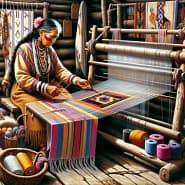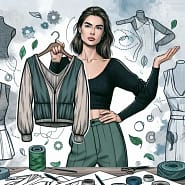Introduction: Understanding the Fast Fashion Industry
Fast fashion: the words reverberate in glossy magazine pages, on the racks of retail giants and on the lips of your favorite influencers. However, beneath the appealing surface lies a deep well of consequences that consumers should be aware of. This article presents The Truth About Fast Fashion: What You Need to Know, a comprehensive look into the pivotal aspects of the fashion industry’s fastest-growing segment.
At a glance, fast fashion refers to:
- Quick turnaround: From design board to storefronts in a matter of weeks.
- Affordable prices: Cutting down on production costs to offer trendy pieces at low prices.
- Fleeting Trends: Producing trendy items for short-term use, promoting a ‘wear-and-dispose’ culture.
These aspects present an incredibly efficient business model designed to cater to evolving consumer tastes. But what are the true costs of fast fashion? Beyond the appealing blend of speed and cost-effectiveness lies a series of alarming implications. The ensuing sections of this article will delve into:
- The environmental impact of fast fashion.
- Labor practices in the fast fashion industry.
- Social implications of fast fashion.
- Fast fashion versus sustainable fashion.
- How consumers can make a difference.
By dissecting these crucial facets of fast fashion, we aim to raise awareness, drive conversation and foster responsible of consumer culture. After all, fashion should be a way to express ourselves without the expense of our planet or the people who inhabit it.
Stay with us as we venture into the intricate world of fast fashion. It is crucial to understand the true cost of the latest trends.
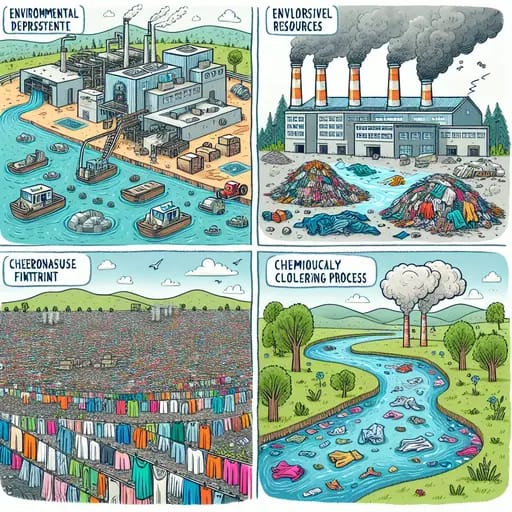
Environmental Impact of Fast Fashion
It’s impossible to discuss fast fashion without addressing the elephant in the closet: the vast damning environmental impact this industry has on our planet. Here, we bring you a deep-dive into how fast fashion accelerates climate change and significantly contributes to environmental degradation.
1. Rapidly Depleting Resources:
Clothing production has roughly doubled since the year 2000, which in turn means increasing demand for natural resources. For instance:
- It takes approximately 2,720 liters of water to produce just one cotton shirt – enough to meet the average person’s drinking needs for two-and-a-half years.
- Globally, 93 billion cubic meters of water – enough for 5 million people to survive – is used by the fashion industry each year.
2. Excessive Waste Production:
The fast-paced nature of fashion trends coupled with poor-quality garments has created a throw-away culture, significantly adding to global waste:
- Around 85% of all textiles are discarded every year, with the majority ending up in landfills or incinerators.
- Less than 1% of material used to produce clothing is recycled into new clothing.
3. Pollution:
Fast fashion is a major contributor to various types of pollution:
- The industry is responsible for 20% of all industrial water pollution globally.
- Fashion is considered the second largest consumer-related source of microplastic pollution.
4. Greenhouse Gas Emissions:
The fashion industry spans several sectors, from agriculture to manufacturing and logistics, each producing a significant amount of greenhouse gases:
- The global fashion industry produces 10% of humanity’s carbon emissions – more than all international flights and maritime shipping combined.
5. The Impact of Dyeing and Finishing:
The dyeing and finishing process is a particularly hazardous part of clothes manufacturing due to its toxic impact:
- Approximately 200 tonnes of water are needed for each tonne of fabric dyed.
- Wastewater from dye houses that discharge untreated effluents into the environment can cause severe water pollution.
In conclusion, the environmental impact of fast fashion is far-reaching and severe, necessitating a significant shift towards more responsible and sustainable practices in the industry.
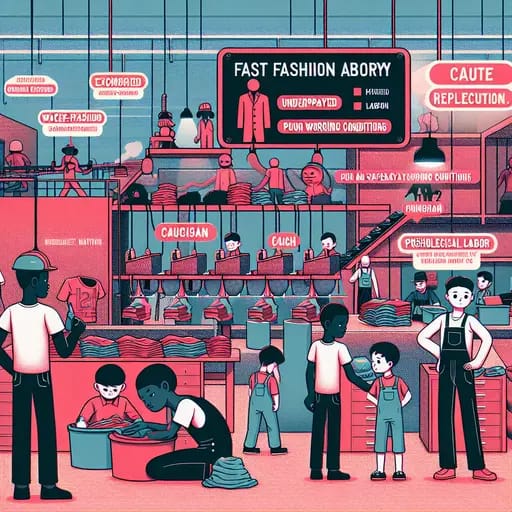
Labor Practices in the Fast Fashion Industry
As we delve deeper into the intricacies of the fast fashion industry, one can’t ignore its labor practices. Fast fashion has revolutionized the fashion industry, delivering affordable clothing and trends to the masses. However, the cost of these inexpensive items is often paid by those employed within the sector. The industry is notorious for its labor abuses, which include low wages, inadequate working conditions, and even child labor.
1. Wage Exploitation
A predominant issue within the industry is wage exploitation. Workers are severely underpaid, working long hours for wages that are below the living standard in various outsourcing countries. This is primarily due to the desire to keep production costs low to ensure high profits.
- – In Bangladesh, for instance, many garment workers earn less than $1 a day, a wage way under the living wage.
- – In Cambodia, the minimum wage for garment industry workers is $140 per month, lower than the recommended $187 monthly living wage.
2. Poor Working Conditions
Another significant concern is the poor working conditions within fast fashion factories. Workers often endure situations that ignore labor laws and infringe on human rights. These conditions include long working hours, lack of health and safety measures, and psychological abuse.
- Factories in Bangladesh and India are notorious for their safety issues, with instances of factory collapse and fires causing many fatalities.
- In China, textile workers suffer from occupational diseases due to exposure to dangerous chemicals without proper safety equipment.
3. Child Labor
The industry is also blighted by cases of child labor. Despite international laws prohibiting child labor, this practice persists across several fashion producing nations. This is mostly attributed to poor enforcement of labor laws and poverty.
- – In countries like India, Bangladesh, and China, children are often subjected to labor in the textile industry, sometimes forced to work in terrible conditions for extended hours.
The labor practices in the fast fashion industry are a dark side to the bright, trendy pieces we find in our favorite stores. However, consumer awareness about these practices is growing, leading to a call for change. As we move to the next section, we will look at the social implications of fast fashion.
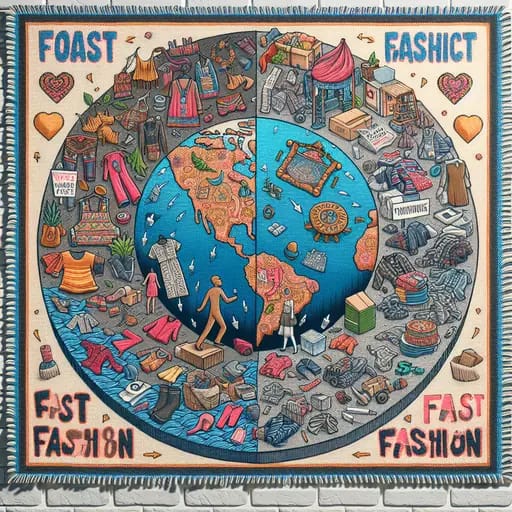
Social Implications of Fast Fashion
In our study of “The Truth About Fast Fashion: What You Need to Know“, it becomes imperative to understand the social impacts of this industry. In this section, you will discover the often overlooked social consequences of fast fashion.
- Social Inequality: This sector is infamously known for exploiting labor, with cases of low wages, poor working conditions, and even child labor. It’s fraught with social injustice, strengthening the economic divide between developed and developing nations.
- Impact on Local Businesses: With the rise of fast fashion retailers, small and local businesses often struggle to compete. Traditional and artisan craft industries are also at risk of becoming obsolete due to the speed and affordability of these mass-produced items.
- Cultural Appropriation: Oftentimes, fast fashion brands have been scrutinized for exploiting cultural symbols without understanding their historical and symbolic importance. This not only disrespects the culture but also contributes to diluting and homogenizing global cultures.
- Throwaway Culture: Fast fashion feeds into the societal norm of overconsumption and discarding items quickly. This contrasts sharply with the more traditional approach to clothing, where items would be cherished, cared for and repaired over many years.
- Poor Quality and Waste: This industry encourages low-quality garments with a short lifespan, contributing significantly to textile waste. This, combined with low recycling rates, is a substantial social and environmental problem.
Impressively, the fast fashion industry has leveraged its global reach to influence societal norms and behaviors around the world. However, it’s essential to note that these social implications are interconnected with environmental and labor issues.
To delve deeper into the comparison between fast fashion and sustainable industries, continue to the next section, “Fast Fashion vs. Sustainable Fashion“. This critical dive will give you a broadened perspective on informed choices in the world of fashion.
In this quest for truth about the fast fashion industry, you will be armed with the knowledge to make a difference. As consumers, we have the power to change our buying habits and promote a more equitable and sustainable world of fashion.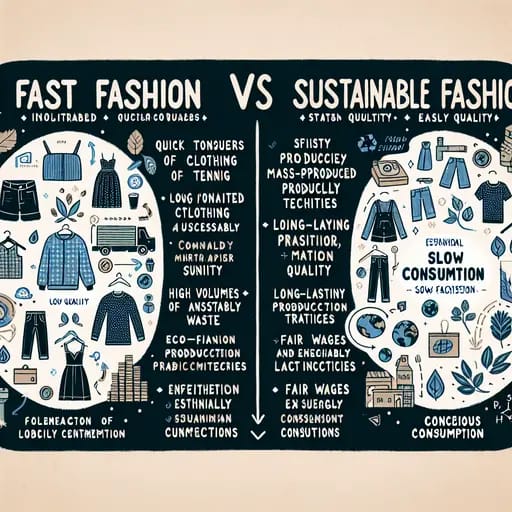
Fast Fashion vs. Sustainable Fashion
As we delve deeper into the truth about fast fashion, it becomes imperative to draw a parallel with its alternative–sustainable fashion. The contrast between the two models reveals the pressing need for a shift towards more responsible practices in the fashion industry.
- Fast Fashion: As a model, fast fashion thrives on quick turnaround times, resulting in clothing that is cheap, trendy, and produced in mass. It operates on a constant cycle of high volume and low-quality clothing. Its primary focus is on imitating high-end fashion trends and making them accessible to the mass market at a low cost.
- Sustainable Fashion: In stark contrast, sustainable fashion or “slow fashion” adopts a circular approach that values both people and the environment. This model pursues quality over quantity, creating long-lasting garments that have minimal impact on the environment during their production, use, and disposal.
Now, let’s dive a little deeper:
- Environmental Impact: Fast fashion contributes significantly to environmental pollution due to its rapid and wasteful nature. Sustainable fashion, on the other hand, invests in eco-friendly materials and energy-efficient production techniques.
- Ethical Considerations: Fast fashion often overlooks fair labor practices for the sake of profit, resulting in exploitation. Contrarily, sustainable fashion emphasizes on ethical labor practices, ensuring fair wages and safe working conditions.
- Consumer Habits: Fast fashion encourages consumers to regularly buy and discard clothes—a practice that fosters a throwaway culture. Sustainable fashion promotes conscious consumption, encouraging individuals to buy less, choose well, and make it last.
In a nutshell, while fast fashion is synonymous with short-lived trends and a disregard for environmental and labor rights, sustainable fashion stands for longevity, respect for the environment, and social justice. Unveiling the truth about fast fashion brings into light the profound need for more sustainable practices in the realms of production, consumption, and waste management in the fashion industry.
As we move along in our venture to know fast fashion and its alternatives, let us explore the potential role of consumers in this fashion revolution.
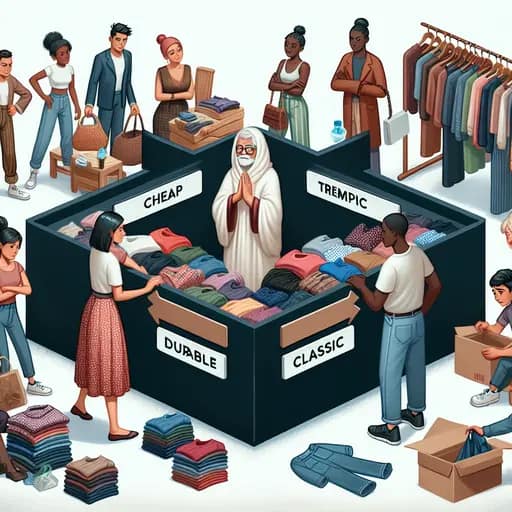
How Consumers Can Make a Difference
As we’ve already learned, the implications of fast fashion, both socially and environmentally, are much larger than many realize. Consumers, however, have the power to make a vital difference. By shifting our patterns, focusing on sustainable practices, and making mindful decisions, we have the potential to enact considerable change in the fashion industry.
Here are several ways consumers can directly combat the issues surrounding fast fashion:
- Buy fewer, but higher quality, items: Invest in versatile, long-lasting pieces rather than trendy, disposable clothing. Initially, these pieces may seem more expensive, but they’ll pay off in the long run by lasting far longer than fast fashion items.
- Support ethical brands: Choose to buy from brands that prioritize ethical labor practices and sustainability. This not only supports these organizations but also sends a strong message to other companies about the values that truly matter to consumers.
- Recycle and repurpose clothing: Rather than throwing away old clothes, consider donating them or selling them to thrift stores. Or get creative and repurpose garments into new fashion pieces.
- Reduce consumption: This might be the most challenging, but reducing our overall consumption can truly make a difference. Consider participating in challenges such as Project 333, which advocates for choosing just 33 items to wear for three months.
These are just a few ways you, as a consumer, can contribute to reducing the negative impacts of fast fashion. Remember that every little step counts towards the larger goal of creating a sustainable and ethical fashion industry.
In the next section, we will explore how sustainable fashion provides an apt alternative to the fast fashion model. Stay tuned to learn how sustainable fashion is beneficial not just for the planet and its inhabitants, but also for the consumers like us.
By carefully assessing our personal wardrobe choices and habits, we can each play a part in curbing the negative impact of fast fashion, supporting the move towards a more sustainable and ethical fashion industry.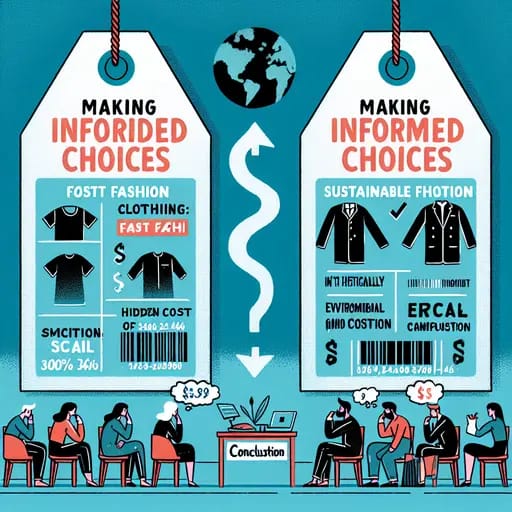
Conclusion: Making Informed Choices in the World of Fashion
In light of the alarming realities surrounding the fast fashion industry, it is more critical than ever to start making informed choices in the world of fashion. Let’s reflect on a few key takeaways that can help us move forward:
- Understanding the real cost: Behind the affordable price tags of fast fashion items lie hidden environmental and social costs. It’s crucial to understand that the actual price of these clothes goes far beyond what we pay at the register.
- Sustainable vs. Fast Fashion: While fast fashion emphasizes speed and low costs, sustainable fashion values ethical labor practices and environmental sustainability. Paying a bit more for sustainable fashion can contribute to a better world.
- Consumer power: As consumers, our purchasing decisions wield great power. Choosing ethically produced and sustainable items over fast fashion products can make a tangible difference in the industry.
- Educate yourself and others: Stay informed about fast fashion and its implications. Share your knowledge with others to create wider awareness and promote change within the industry.
The truth about fast fashion reveals a world that often hides behind the glitz and glamour of the fashion industry. Yet, it also pointedly illuminates the power and potential each of us have to help effect real change in this sector. By making informed choices, we can contribute to an industry that values and works towards sustainability and ethical business practices over profits.
In conclusion, understanding the truth about fast fashion and the impact our buying habits have can empower us to make more responsible, conscious choices. Let us remember that fashion, ultimately, isn’t just about looking good – it’s about feeling good in what we wear, knowing it’s been produced with care for our planet and its people.



